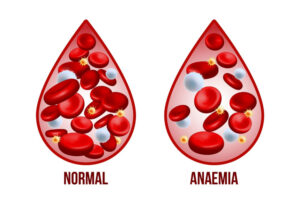Have you been feeling unusually tired, weak, or short of breath?
It might be more than just a busy week or lack of sleep.
One of the most common and often overlooked causes of chronic fatigue is iron deficiency anaemia (IDA).1,2
WHAT IS IRON DEFICIENCY ANAEMIA (IDA)?

Iron deficiency anaemia is a condition that occurs when your body does not have enough iron.
Without sufficient iron, your body struggles to make enough haemoglobin, a vital protein in red blood cells.2
Think of haemoglobin as a delivery truck that picks up oxygen from your lungs and transports it throughout your body.
When haemoglobin levels drop, less oxygen reaches your tissues and organs, leading to fatigue and other health concerns.
Anaemia and Iron Deficiency Anaemia (IDA) in Malaysia
In Malaysia, anaemia affects 21.3% of the population, with 3 in 10 women aged 15–49 being anaemic.³ While specific national data on the prevalence of iron deficiency anaemia (IDA) is currently unavailable, IDA remains one of the most common causes of anaemia both globally and locally.
This is supported by findings from the NHMS 2019, which showed that a significant proportion of Malaysians have inadequate daily iron intake:
- Adolescents: 54.1%
- Adults: 56.7%
- Older people: 34.6%.⁴
These figures suggest a substantial risk of iron deficiency among Malaysians, potentially contributing to the national anaemia burden.
HOW DOES ONE DEVELOP IDA?
The most common factors that increase the risk of IDA include:
Blood Loss
Women with heavy menstrual bleeding can lose up to 5 times more blood than women with normal periods. As a result, they also lose a significant portion of their stored iron. Over time, if iron stores aren’t replenished, this can lead to IDA.¹
People with gastrointestinal bleeding may also experience iron depletion due to blood loss.²
Decreased Intake of Iron and/or Increased Iron Needs
Certain life stages and conditions increase iron requirements. For example, during pregnancy and breastfeeding, when mothers must meet both their own and their baby’s nutritional needs.¹
Poor absorption of iron can also occur in people with conditions such as coeliac disease, or those who’ve undergone certain surgeries.¹
Other Factors
Health conditions associated with an increased risk of IDA include:¹
- Gastritis
- Peptic ulcer disease
- Gastric (stomach) cancer
- Oesophagitis (inflammation of the oesophagus)
- Inflammatory bowel disease (IBD)
- Obesity (particularly among men)
HOW TO SPOT IDA EARLY
Recognizing the symptoms early and seeking medical attention can help prevent more serious health issues later.
Here are some common signs of iron deficiency anaemia to watch out for:
- Unusual tiredness1,2
- Feeling of weakness1,2
- Shortness of breath, especially during activities like exercising or climbing stairs2
- Headaches¹
- Hair loss¹
If you notice these symptoms in yourself or a loved one, it’s important to consult a healthcare professional for further evaluation.
WHEN YOU SEE A HEALTHCARE PROFESSIONAL
When you consult a healthcare professional, they will aim to:
- Confirm whether your symptoms are due to IDA.
- Rule out other potential underlying conditions.
The most reliable way to check for iron deficiency is by measuring ferritin levels, which show how much iron is stored in the body.5
However, doctors usually start with a complete blood count (CBC) test, which checks the haemoglobin level in your blood.6 If haemoglobin is low, it may indicate anaemia.6
To find out if it’s caused by a lack of iron (IDA), further tests like blood iron levels, ferritin, transferrin, and total iron-binding capacity (TIBC) may be done. These tests help confirm whether the anaemia is due to iron deficiency and guide treatment.5,6
In some cases, your doctor may also order a bone marrow aspiration or biopsy to confirm the diagnosis.2
WHAT HAPPENS IF YOU ARE DIAGNOSED WITH IDA?
The good news is that IDA is both preventable and treatable.
Management typically involves:
- Making dietary changes.
- Following medical advice, including medications if prescribed.
- Taking iron supplements, where necessary.
Dietary Changes
Eat more iron-rich foods
Increasing your intake of iron-rich foods is a simple but essential step. Good options include:
- Meat, poultry, fish5
- Green leafy vegetables and legumes5
Consume foods rich in nutrients that can boost iron absorption
Additionally, include foods rich in vitamin C such as oranges, guavas, and bell peppers, as they can significantly enhance your body’s absorption of iron.5
| If you follow a plant-based diet, it’s advisable to seek guidance from a dietitian on how to increase the iron content and optimize absorption from your meals.5 |
Iron Supplements
When diet alone isn’t sufficient, your doctor may recommend oral iron supplements.
Available forms include:
- Ferrous sulphate⁶
- Ferrous fumarate⁶
- Ferrous gluconate⁶
For best absorption, they should be taken on an empty stomach.2
While some people may experience side effects like nausea, adjusting the dosage or trying a different formulation can help.2
Ferrous Gluconate
|
BE PROACTIVE, DON’T LET IDA CONTROL YOUR LIFE
If you’ve been struggling with unexplained fatigue or other concerning symptoms, it might be time to see a doctor to determine whether iron deficiency anaemia is the hidden cause.
This condition is common, but with the right care and awareness, it is both preventable and treatable.
So be proactive — talk to your doctor, get tested, and take simple steps to support your iron levels.
A healthier, more energized you is within reach!
This article is brought to you by P&G Health

References:
- Świątczak, M., Młodziński, K., Sikorska, K., Raczak, A., Lipiński, P., & Daniłowicz-Szymanowicz, L. (2022). Chronic fatigue syndrome in patients with deteriorated iron metabolism. Diagnostics (Basel, Switzerland), 12(9), 2057. https://doi.org/10.3390/diagnostics12092057
- Warner, M. J., & Kamran, M. T. (2023, August 7). Iron deficiency anemia. In StatPearls. StatPearls Publishing. Retrieved May 19, 2025, from https://www.ncbi.nlm.nih.gov/books/NBK448065/
- Ganapathy, S., Jawahir, S., & Tan, L. (2020). Key findings of NHMS 2019. https://iku.moh.gov.my/images/IKU/Document/REPORT/NHMS2019/Infographic_Booklet_NHMS_2019-English.pdf
- Ministry of Health Malaysia. (2024). National Health and Morbidity Survey fact sheet: Nutrition. https://iku.nih.gov.my/images/nhms2024/fact_sheet_nhms2024.pdf
- Short, M. W., & Domagalski, J. E. (2013). Iron deficiency anemia: evaluation and management. American family physician, 87(2), 98–104.
- Iron-deficiency anemia. (n.d.). Hematology.org. https://www.hematology.org/education/patients/anemia/iron-deficiency
- Skolmowska, D., Głąbska, D., Kołota, A., & Guzek, D. (2022). Effectiveness of dietary interventions to treat iron-deficiency anemia in women: A systematic review of randomized controlled trials. Nutrients, 14(13), 2724. https://doi.org/10.3390/nu14132724
- Nguyen, M., & Tadi, P. (2023, July 3). Iron supplementation. In StatPearls. StatPearls Publishing. Retrieved May 19, 2025, from https://www.ncbi.nlm.nih.gov/books/NBK557376/
- Meng, K. (2024). Understanding ferrous gluconate: Uses, benefits and considerations. Advanced materials science research, 7(4), 195–196.









